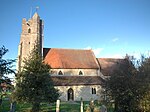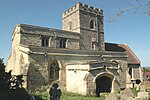Looping Star (Clacton Pier)
Looping Star is a steel roller coaster located at Clacton Pier in Clacton-on-Sea, Essex manufactured by Pinfari. It was formerly located at Codonas Amusement Park in Aberdeen, Scotland. It was the park's only ride with an inversion, built on top of the mini-golf and restaurant. It replaced the Galaxi roller coaster, which was moved to Loudoun Castle amusement park (now defunct). The ride used to have three trains, but after 2010 the ride operated 2 trains, then some point in 2017 The coaster operated just 1 train (the other two are sitting on the transfer track). They use the newer Pinfari trains, which can be seen on rides built from the mid 1990s onwards. The Looping Star has now been moved to Clacton Pier, where it was intended to be assembled and open for the 2020 summer season, however, as a result of damage from Storm Ciara, it was opened on the 23rd October 2021 instead.
Excerpt from the Wikipedia article Looping Star (Clacton Pier) (License: CC BY-SA 3.0, Authors).Looping Star (Clacton Pier)
Holly Lane, South Oxfordshire Stanton St John
Geographical coordinates (GPS) Address Nearby Places Show on map
Geographical coordinates (GPS)
| Latitude | Longitude |
|---|---|
| N 51.7864 ° | E -1.155 ° |
Address
Holly Lane
Holly Lane
OX33 1HJ South Oxfordshire, Stanton St John
England, United Kingdom
Open on Google Maps









